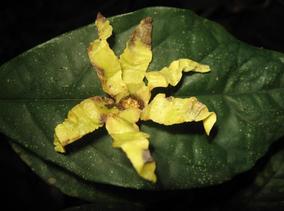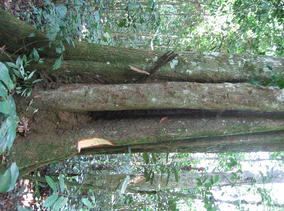You are here
Annonaceae
Hexalobus crispiflorus A.Rich.
Nomenclature
-
Tribe: MonodoreaeGenus: Hexalobus
-
Synonyms: 3
SUMMARY
Evergreen tree of up to 40 m tall; trunk up to 1 m dbh, deeply channelled (giving it the appearance of a bundle of columns); bark c. 5 mm thick, longitudinally fissured, peeling off in narrow, long papery flakes, brown to rusty-brown, quickly turning orange-brown when cut; twigs, leaves and petioles densely hairy when young. Leaves: petiole 2-8 mm long, 1-2.5 mm in diam., covered with brown to whitish hairs; leaf blade elliptic to ovate or obovate, 7.2-25 cm long, 2.5-8.5 cm wide, apex acuminate with a blunt tip, base cordate to rounded or sometimes cuneate, coriaceous; upper surface sometimes slightly bullate, glossy, often greyish, glabrous, lower surface brown when dry, sparsely covered with appressed, light brown hairs of c. 0.3 mm long; midrib covered with small, erect, white hairs above, below covered with appressed, light brown hairs; secondary veins distinct on each side, 9-19 pairs, at angles of 42-75º with the midrib. Flowers 1-3 together on simple or branched short shoots, fragrant; flower stalk 12-25 mm long; the part of the flower stalk below the articulation 2-13 mm long, 1-2 mm in diam., in fruit 4-9 mm in diam.; bracts 5-6, two upper ones barely to distinctly fused at base and then forming a tube to 4 mm long, soon falling except when fused, 8-12 mm long, 4-9 mm wide; part of the flower stalk above the articulation 4-17 mm long, 1.2-3 mm in diam., in fruit 4-10 mm in diam., densely covered with appressed, golden to rusty-brown, c. 0.5 mm long hairs; buds ovoid to more or less globose; sepals 12-16 (-21) mm long, (5.5-) 9-12 (-16) mm wide, reflexed at anthesis, outside densely covered with < 0.1 mm, appressed, rusty-brown hairs and with larger, (0.5-) 0.8-1.5 (-2) mm long hairs, inside densely covered with curly hairs; corolla cream to yellow, basal rim dark purple, tube 4-10 mm long, lobes narrowly to broadly lanceolate, all equal or sometimes subequal with those of the inner whorl narrower, 37-60 (-80) mm long, 6-21 mm wide, rounded at apex, outside with appressed, light coloured to brown, 0.1-1 mm long hairs, apical hairs shorter than basal ones; inside covered with appressed, c. 0.1 mm long hairs, base glabrous or sparsely covered with curly, fine, white, long hairs; stamens numerous, oblong or sometimes slightly broadening towards apex, 3-5.1 mm long, 0.5-0.8 mm wide, connective appendage semi-globose to slightly convex; carpels 7-16, 2-4.5 mm long, 1-1.3 mm wide, densely hairy; stigmas attached to the top of the ovary, often bending in a horizontal position, 2.1-3.5 mm long, (1.1-) 2.2-3.1 mm wide. Monocarps 1-5 (-8), subsessile, ellipsoid to oblong, (4.2-) 5-9.5 cm long, 3.5-6.5 cm in diam., smooth, glabrous or densely covered with velutinous, rusty-brown, c. 0.1 mm hairs; seeds c. 12-36, biseriate, flattened ellipsoid with convex or plano-convex sides, 28-40 mm long, 17-20 mm wide, 5-9 mm thick, rusty-brown to dark brown, dull to slightly shiny, raphe flat, slightly darker brown.






